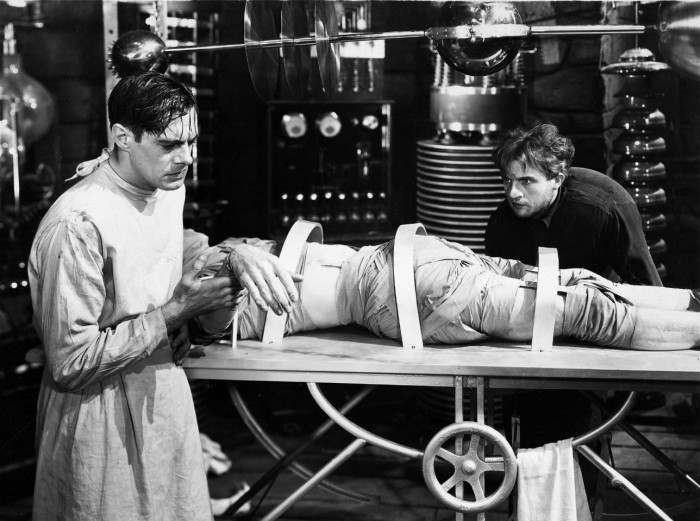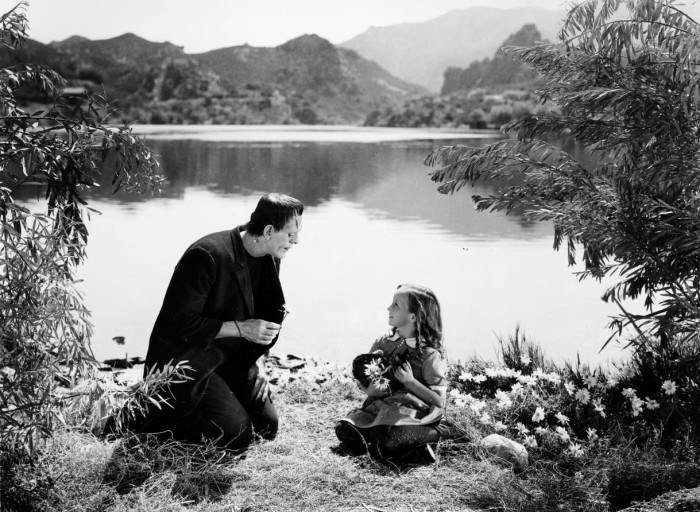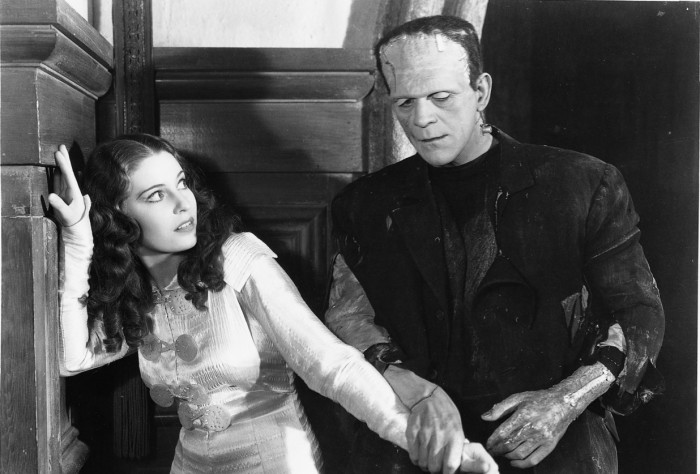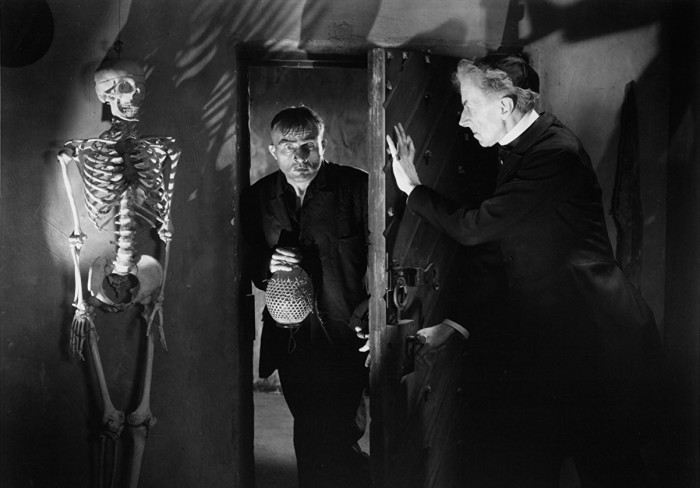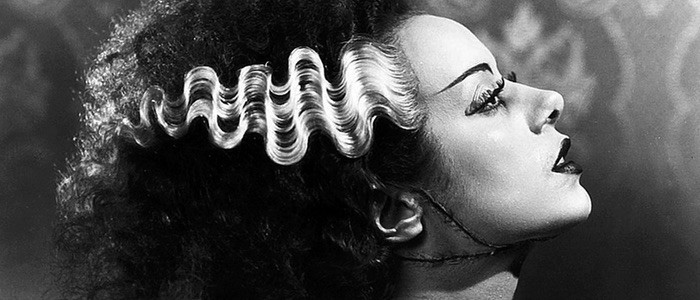A Horror Newbie Watches 'Frankenstein' And 'Bride Of Frankenstein' For The First Time
(Welcome to The Final Girl, a regular feature from someone who has steered clear of horror and is ready to finally embrace the genre that goes bump in the night. Next on the list: James Whale's two monster movie classics, Frankenstein and Bride of Frankenstein.)
When /Film managing editor Jacob Hall told me that the first two movies I would be watching after It were Frankenstein and Bride of Frankenstein, I breathed a sigh of relief. No. I was more than relieved, I was ecstatic. Gothic romance! The birth of science fiction! Pre-Code movies! Those were my bread and butter.
So it came as a quiet surprise to me that I hadn't actually seen or read Frankenstein yet. I knew of the mythos, of course — the bolt-headed monster, the frantic shrieks of "It's alive," Gene Wilder and Mel Brooks' hysterically funny satire of the classic movie, Young Frankenstein. I was so familiar with the beats of the story and had seen famous scene countless times in the background of other movies, but had never actually watched James Whale's 1931 classic and its sequel. It was high time to remedy that.
I decided to watch the movies first before reading Mary Shelley's book, which I had bought long ago and was collecting dust somewhere in my bookshelf. I wanted to go in fresh — if such a thing were possible for a story that has become one of the most universally known monster movies in history.
Frankenstein (1931): The Makings of a Monster
The first thing I noticed right off the bat was that Frankenstein's Monster was kept a mystery in the opening credits, marked as simply "?" This feels like a bold move for Hollywood which, in 1931, was on the cusp of perfecting the studio system that would beget the Golden Age of Hollywood in the late '30s and early '40s. No star? No Bela Lugosi, who had recently risen to fame with Dracula and was apparently first choice for the part? How bold!
The actual beginning of the movie feels just as bold, with the first shot panning to the skeletal grim reaper standing watch over a funeral, which ends shortly before the hunchbacked Fritz pops his head up and helps his master Frankenstein to exhume the body. (Now that I mention Lugosi, I wonder if that imagery is a reference to Lugosi's refusal to play The Monster because he did not come to America "to be a scarecrow.") Whatever the case, the film is already oozing macabre, three years before the term "horror" was coined as a movie genre.
But it doesn't quite feel that Gothic either, with an empty impressionistic painted background filling in for the cloudy skies, and Fritz's wide-eyed deformity lending to the movie's abject, but somewhat superficial, atmosphere. Whale plays with a jumble of elements that swing between hyper-artificial and hyper-realistic: the barren medieval architecture of Frankenstein's laboratory surrounded by industrialist — almost steampunk-looking — equipment, the extravagant Gothic mansion that Frankenstein's fiancée Elizabeth inhabits, the sun-kissed daytime setting of the village and forest, and the heightened artificiality of the weather-beaten cliff and stark night sky.
Aside from its ostensibly Gothic roots, Frankenstein reminded me of the German Expressionism movement — especially in its use of silhouettes and shadows to highlight the grotesque imagery of the film, like Fritz's hunchback. Those silhouettes provide a nice contract Frankenstein with his all-white uniform, which cuts a severe form for the already pale and wan Colin Clive.
Let's talk a little about Fritz. I was surprised to learn he was an invention of the movie, so entwined he's become with the legacy of Frankenstein. As the years have worn on, he's become as famous as the protagonist and his monster himself, although his name eventually evolved into Igor. The deformed, depraved character taps into the Gothic fascination of insanity and turmoil, literally twisting a person's physique. For much of the film he even acts like a physical manifestation of Frankenstein's twisted core, or his id. The character's basis in Dwight Frye's sinister, electric (hah) performance is all the more fascinating to me, and I wish that Frye's iconic depiction of the obtuse assistant — and whose cruelty is our first indication that humans were the real monsters — could be remembered just as well as Boris Karloff's Monster.
But Clive's performance impressed me the most. While melodramatic, there is no affect to his frenetic, unhinged portrayal of Frankenstein (amusingly called Henry instead of Victor here). It is almost a modern performance in his complete emotional and physical dedication to the role. His unreserved delivery of "It's alive! It's alive!" amidst the crackling thunder and lightning sends chills down my spine instead of chuckles.
There is plenty to be said — and already has been said — about Karloff's wordless, wildly empathetic performance as the Monster. It's a genius portrayal, and one that has long superseded Mary Shelley's surprisingly erudite Monster. He's caked in movie make-up, he communicates in grunts, and he lumbers like a creature whose limbs are too heavy for him, but still he immediately becomes the most sympathetic character of the entire film, and the epitome of the gentle giant. Karloff managed to inject nuance into the role, which co-star Mae Clarke (Elizabeth) would later praise in an interview speaking about the Monster's first encounter with light:
"I thought Karloff was magnificent. That scene with the skylight! When he looked up and up and up, and waved his hands at the light, it was a spiritual lesson: Looking at God! It was like when we die, the Beatific Vision, which makes people understand the words: 'Eye has not seen, nor ears heard, the glories that God has prepared for those who love Him.'
Still, Frankenstein is not afraid to go into some dark places, especially with Karloff's complicated Monster.
Cracking the Code
I'm about to get excited about the Hays Code here. The Hays Code was Hollywood's set of self-imposed censorship guidelines that preceded the MPAA rating system. It was a response to the moral outrage aimed at Hollywood studios, which had been beset by celebrity scandals and increasingly lewd and violent elements on the big screen as technologies and storytelling techniques evolved. Prohibition was just beginning to wane as the Hays Code was installed in 1934, but much of that moral Puritanism that spawned from that movement transferred to Hollywood instead. While the Hays Code encouraged filmmakers and studios to circumvent the rules in increasingly creative ways that spawned a Golden Age in Hollywood, it set the industry's progress back decades, banning interracial relationships, lengthy kisses, violence, and sympathetic villains.
Removing a sympathetic villain would have hobbled Frankenstein's impact, which relies heavily on the audience sympathizing with a morally grey hero — whether that is Frankenstein or the Monster. Happily, Frankenstein existed in that brief time between the introduction of sound in 1927 and the beginning of the rigid Hays Code in 1934, which allowed it to include scenes that were shocking even to me.
Fritz's violence against the Monster was the first moment that struck me. He brings out a whip to torture the Monster in his cell shortly after he had scared the Monster, who until then had been kept hidden in darkness, with a fiery torch — one of the instances of the bizarre mythological parallels to Icarus, the arrogant son in the Greek myth who flew too close to the sun. That myth has often become a parable for hubris and getting punished for it, but here it is fire that first frightens the Monster, the creation of the mad scientist attempting to ape God. Fun fact: the scene of Dr. Frankenstein euphorically yelling, "It's alive! In the name of God! Now I know what it's like to BE God!" was nearly lost to the ether after the Hays Code was installed — but was restored in later editions.
Of course, the most harrowing scene that became a source of controversy even before the Hays Code was the accidental drowning of the young girl who befriends the Monster. Set during daytime in an expansive outdoor meadow — a jarring contrast from the painted backgrounds — the wandering Monster stumbles upon a little girl throwing flowers into a lake. Unlike all the adults he had encountered, she is undeterred by his appearance and asks him to join her and they take turns throwing her handful of flowers into the water to see them float. But when they run out, the excited Monster grabs the girl and throws her into the water, assuming that she would float too. But she doesn't reappear, and distraught, the Monster flees. The scene walks a tightrope of sympathy, becoming the turning point in which the audience is given the choice to indict the Monster. The story eventually moves on before you can make a decision, but lingers long enough so that you can ruminate on the shocking event that just unfolded — made all the more so by the cheery, realistic setting.
Frankenstein thrives in these classic juxtapositions — later made even more distressing when the jubilant village atmosphere is interrupted by the dazed father stumbling through town with his dead daughter in his arms. How quickly the cheering crowd quickly turning to a mob, and how quickly the innocence of daytime suddenly returns to the claustrophobic nighttime sets.
The final image of the windmill up in flames as the Monster is chased down by the angry mob is stunning, and an ending that could only be achieved in a Pre-Code film. Though the Monster is supposedly killed while Frankenstein lives, Frankenstein oddly leaves you with a hallow, existential feeling. There is no finality here.
Bride of Frankenstein (1935): Hollywood’s First Great Sequel
I have to confess: I didn't like Bride of Frankenstein as much as Frankenstein. It's bigger, bolder, campier, and draws a lot more from fantasy than science-fiction. While Colin Clive's sallow, tense performance remained a solid constant through the two films, everyone else might as well be acting in different movies altogether.
Elizabeth had been turned into a more classic horror damsel (and a new actress, Vera Hobson), with long brunette locks and flowing white dresses, but in turn had lost the agency that the Gothic elements had granted her (to be fair, the book itself didn't give her much to do either). The Burgomaster is a completely different actor altogether, and there's a million more kooky supporting characters this time around. The most annoying was that of Una O'Connor's Minnie, whose sole purpose it seems is to deliver a funny one-liner every other scene and get saddled with the repeat of the iconic "It's alive!" line.
I had mixed feelings about Dr. Pretorius, whose hammy scene-chewing I enjoyed (I just wanted to mention that my notes describe him as "putting the goth into Gothic"), but whose presence disrupted the steampunk-science vibe of the original. His motivations are also unbelievable for most of the film, but as he's set up as the traditional villain of the movie, I can't expect too much for that. Plus he gets to dramatically utter the famous line, "A new world of gods and monsters," so that makes up for his somewhat confusing presence.
Considering the fact that Bride of Frankenstein is one of Hollywood's early attempts at a direct sequel, it's understandable that they would be ironing out a few kinks. Much of the film is original story with a few elements drawn from the book — the blind man, the Monster learning speech, the Bride — but remains firmly in the stark, stunning world that James Whale created in his first film. Still, that doesn't stop Whale from using the dramatic device of author Mary Shelley narrating the beginning of the sequel to Lord Byron and her husband in the famed retreat where she conceived of the idea. I love that Mary Shelley has become so mythic that she is as much a part of the Frankenstein story as her characters.
Surprisingly, the titular bride only appears in the last 10 minutes of the movie, in an unsettling scene that bears astounding visual parallels to Frtiz Lang's Metropolis (I knew that German Expressionism would find its way back!). But brief as it is, the Bride immediately captures my imagination — her hair standing up on end as if to simulate being electrified, her mummified white gown that subverts the horror damsel's garb, and her dark lipstick that would become a staple of every Halloween party are inspired work by the costume designers John Macfarlane and Vera West. Gushing about the Bride's design aside: Bride of Frankenstein quickly becomes another lesson in hubris. Upon finding his Bride scared of him too, the Monster entraps Pretorius in the tower before destroying it — but in an act of mercmy allows Frankenstein and Elizabeth to escape. It's as much of a Hollywood (and post-Hays Code) ending as you'll get in a movie about a monster whose very existence is an allegory for humanity's darkest capabilities.
Gothic Goodness
Shortly after I finished watching both movies, I finally picked up that forgotten copy of Frankenstein. The story idea was famously spawned from a ghost story-writing competition between Mary Shelley, Percy Shelley, Lord Byron, and John William Polidori as they spent a summer in a Lake Geneva retreat. While James Whale's films are a mishmash of elements, Shelley's book was pure Gothic Romance. The "romance" in the genre name shouldn't be misconstrued as having to solely to do with romance or love, though those elements often do make their way into the story. Rather, Gothic Romances are closer to mysteries or thrillers, set to the eerie backdrop of a medieval castle or a dilapidated mansion. It's all about how extravagance and wealth is a facade for the corruption of the human spirit. Gothic Romance is one of my favorite literary genres — I devoured Charlotte Bronte's Jane Eyre and Daphne du Maurier's Rebecca which, yes, I realize are both romantically inclined.
Shelley's Frankenstein perfectly fits within the genre, taking much of the unsaid elements of the Gothic Romance and manifesting them into a literal monster. But the monster in Shelley's story is less a lumbering hulk than he is a deformed, fallen philosopher, launching into weighty monologues about the essence of man and the cruelty of the world.
"All men hate the wretched; how, then, must I be hated, who am miserable beyond all things!" the monster says when he and Frankenstein first meet — a far cry from the grunts and "GOOD" that make up the dialogue from Karloff's Monster. His journey is much the same, though — he begins naive and pure, but is slowly corrupted by the hatred and venom that others direct his way, eventually becoming a murderer and savage. See? It's society that is to blame
But the simplicity of the movies have percolated into the popular consciousness far more than this erudite "daemon" as Frankenstein calls him. The imagery of the lynch mob chasing a creature who accidentally committed a crime is so much more powerful than the slow existential poisoning of a wandering creature.
Final Thoughts
It's always eye-opening to go back to the beginning. Frankenstein and Bride of Frankenstein deserve their high standing in the pop culture pantheon, not just for their illustrious visuals, but also for how surprisingly funny they are. The films aren't all Gothic anguish — though Clive has a wonderful monopoly on that — but charming films that balance the grim, existential loathing of humanity with banal moments of every day life. The doddering Baron Frankenstein from Frankenstein, the quirky villagers from the second, and Dr. Pretorius' hamfisted villainy all lend levity to movies that wouldn't be the same without.
And though Frankenstein has all the makings of a rapidly assembled B-movie, there are the beginnings of familiar film tropes that even I, unacquainted to the genre as I am, recognized right away — the suspense of a terrifying unseen monster in a mirror, the unsettling use of high, low, and Dutch angles. They're all techniques that will be honed and perfected by masters of suspense like Alfred Hitchcock, and used incessantly in horror movies today. (That mirror trick, it gets me every time.)
To this day, it's rare to find a movie with such depth of character and such overwhelming empathy as Frankenstein. I can understand the adulation for it, and will confess that I've now become a fan. And how couldn't I be? Gothic goodness, pre-Code pulp, the birth of science-fiction, and the beginnings of a cinematic genre? My bread and butter.

